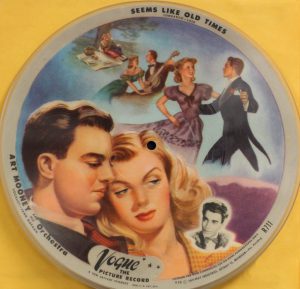They were supposed to mark “The Birth of a New Era in Recorded Music,” however, the era of Vogue Records was in fact a short and bittersweet one. Founded in 1945 by inventor and entrepreneur Tom Saffady, Detroit-based Vogue Records was best known for its colorful, eye-catching, whimsical, and somewhat campy album illustrations.
Production began in the spring of 1946 and by October 1946, Vogue Records claimed to be cranking out 300,000 records a month. However, by August 1947, Sav-Way Industries, the parent company of Vogue Records, was in receivership. While the novelty of the graphics and good tone quality appealed to buyers, the relatively high retail cost of $1.05 a record-compared to roughly fifty cents for a standard record-proved to be too much for the consumer. Retail cost combined with Vogue Records inability to attract big-name talent soon sealed the company’s fate.
The January 11, 1947 edition of The Billboard [Magazine] reported that Vogue Records was understood to be for sale to the tune of $900,000 USD. An article in the May 17, 1947 edition of The Billboard [Magazine] hinted at past troubles by stating the company had been “burned in the past by turning out larger editions of releases than its distributor-dealer set-up could absorb.” Receivership and restructuring efforts were announced in August 1947, but Vogue Records could not be salvaged. Only seven years later, Vogue Records founder, Tom Saffaday succumbed to leukemia at just 37 years of age.
The January 11, 1947 edition of The Billboard [Magazine] reported that Vogue Records was understood to be for sale to the tune of $900,000 USD. An article in the May 17, 1947 edition of The Billboard [Magazine] hinted at past troubles by stating the company had been “burned in the past by turning out larger editions of releases than its distributor-dealer set-up could absorb.” Receivership and restructuring efforts were announced in August 1947, but Vogue Records could not be salvaged. Only seven years later, Vogue Records founder, Tom Saffaday succumbed to leukemia at just 37 years of age.
CKUA’s collection spans the breadth of recorded sound, including recordings made by corporations long since defunct. The Vogue Records trend was a minor blip in music history, however, today’s collectors count these colourful albums among their treasures. Albums range in value from thirty to a few thousand dollars depending on condition and rarity.
With much of its corporate records either lost or destroyed, it is believed that Vogue Records produced around 74 different titles during its short history. The CKUA archives contain five titles by Vogue Records. The station originally believed that the collection contained four Vogue Records, but a fifth album was recently discovered by a volunteer sorting 78 rpm records in the archives. With over 1.5 million items in the CKUA collection, there are still many hidden gems waiting to be discovered in the vault.




